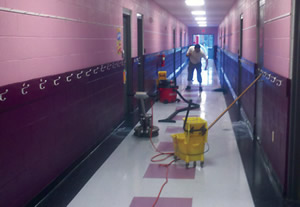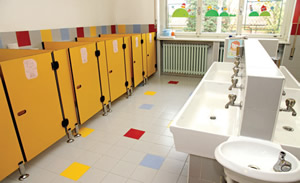Creating Healthy Schools

PHOTO © PRESSMASTER/SHUTTESTOCK
“It’s not important to have green schools, it’s important to have healthy schools,” begins Claire Barnett, executive director of Albany, N.Y.-based Healthy Schools Network (HSN), the leading national voice for children’s environmental health at school. She explains herself by reviewing the recent history of healthy school environments: “In the 1970s and ‘80s, there was a push for energy efficiency, so ventilation systems were closed in a lot of schools. This created a legacy of sick buildings. As a result, a grass roots movement for creating healthy school environments began.”
Dovetailing with this grass roots movement, at the end of 2006, the National Research Council (NRC) in Washington, which is the operating arm of the National Academy of Sciences and the National Academy of Engineering, and whose mission — according to its website — is to “improve government decision making and public policy, increase public understanding, and promote the acquisition and dissemination of knowledge in matters involving science, engineering, technology and health,” published a report called, “Green Schools: Attributes for Health and Learning.” The report includes an assessment of the potential human health and performance benefits of improvements in the building envelope, indoor air quality, lighting and acoustical quality.

PHOTO © SEAN MULGREW
“The report indicates that green schools do not have attributes that equate to health and learning,” says Barnett. “Healthy schools are clean, quiet, dry, free of dust and particulates, and have good Indoor Air Quality (IAQ), and none of those factors are associated with green school design. Historically, green schools were meant to reduce the impact on land, air and water and promote energy and water conservation, which are great things that should be embedded in design, but not be misconstrued as healthy.”
A ROLE MODEL
One school district that is working diligently to create healthy schools is Blue Valley School District (BVSD) in Overland Park, Kan. “It may seem obvious, but we want to do everything we can to ensure students are achieving their potential academically, socially and emotionally,” says David M. Hill, AICP, REFP, BVSD’s executive director of Facilities and Operations. “We know that an excellent indoor environment is a key component to children reaching or achieving their potential.”
BVSD even promotes a tagline: Education Beyond Expectations. “We believe we set the bar high for every department in our district, not just educational services, including human resources, the business office, technology, and food and nutrition to provide an education beyond expectations,” Hill says.

PHOTO PHOTO © SEAN MULGREW © FEDERICOFOTO/SHUTTESTOCK
To that end, the district has participated in studies and won awards for its facilities and IAQ. “We don’t do research, but we are willing participants in and consumers of research,” says Hill. “Since our IAQ program has become formalized with surveys, our test scores have soared.” He notes that he district doesn’t promote that IAQ alone accounts for improved test scores. “We have excellent curriculum and teachers, a strong board of education and support from the community, and all those things work together to improve test scores.”
THE RESEARCH
If, like BVSD, you’re ready to move toward creating a healthy school environment, there are myriad reports, studies and other information available to help you make your case within your district and help you get started. Here are more than a dozen.
- Research about the benefits of green schools by U.S. Green Building Council’s Center for Green Schools, Washington: www.centerforgreenschools.org
- “Green Cleaning in Schools: A Guide for Advocates,” published by Regional Asthma Management & Prevention (RAMP), Oakland, Calif.: www.phi.org
- “Green Cleaning Schools,” an issue of The State Education Standard, the journal of the National Association of State Boards of Education (NASBE), Arlington, Va.: www.nasbe.org
- Chicago-based Healthy School Campaign Website:
www.greencleanschools.org
- Chicago-based Healthy School Campaign announces Transpare, a tool to select healthy and sustainable products: www.healthyschoolscampaign.org
- Green Schools Initiative, Berkeley, Calif.: www.greenschools.net
- “The Benefits of Green Schools: A Triple Bottom Line Approach,” published by Washington-based American Institute of Architects (AIA): www.aia.org
- EPA’s Indoor Air Quality Tools for Schools webpage, which is dedicated to indoor air quality, student health and academic achievement: epa.gov
- “New & Retrofit Green Schools: The Cost Benefits and Influence of a Green School on its Occupants,” a report published by McGraw Hill Construction: construction.com
- “Green Cleaning Programs in Schools Get High Scores,” a white paper by ABM Industries: www.abm.com
- Washington-based U.S. Environmental Protection Agency’s (EPA) Indoor Environments Division’s website: www.epa.gov/iaq
- Washington-based U.S. Environmental Protection Agency’s (EPA) Healthy School Environment’s website: www.epa.gov/schools
- Washington-based U.S. Environmental Protection Agency’s (EPA) Office of Children’s Health Protection website: yosemite.epa.gov
- Washington-based U.S. Environmental Protection Agency’s (EPA) HealthySEAT software website: www.epa.gov
- Washington-based U.S. Green Building Council’s (USGBC) website: www.usgbc.org
- Sacramento, Calif.-based Collaborative for High Performance Schools Website: www.chps.net
WAIT, THERE’S MORE

PHOTO © MICHAELJUNG/SHUTTESTOCK
Making a Difference. Do the facilities in which our children learn really matter? They do! In fact, students attending a school in “excellent condition” score an average of 10.9 points higher on achievement tests than students attending schools in “poor” condition. So, it goes without saying that clean, quiet, safe, comfortable and healthy environments are an important component of successful teaching and learning.
Based on her experience, Barnett vouches for the work of many of the above-listed organizations. For example, she strongly recommends looking to the EPA for guidance on IAQ, particularly if a district has a high proportion of students with asthma or learning disabilities. “Through the last 15 years, the EPA has established an astounding record for a federal agency in advancing healthy school environments for children,” she observes. “They have several programs, such as IAQ and Integrated Pest Management (IPM), and all the offices work together to best achieve healthy school environments.”
Barnett similarly sings the praises of the USGBC. “They recognize that conventional green designs are not always healthy and have established a green group to establish how a healthy environment can better be reflected in the school design process.”
Changing gears, Barnett recommends a “dynamite” report commissioned by EPA and published by the Institute of Medicine in 2011. “Anyone interested in school planning and management should look at ‘Climate Change, the Indoor Environment and Health,’” she says, “because it captures the latest science, finding that indoor exposures are 100 to 1,000 times more intense than outdoor exposures. It addresses the effect of mitigating for climate.” The report can be found at the National Academies Press website: www.nap.edu.
Barnett also recommends a report her own organization published: “Towards Healthy Schools 2015: Progress on America’s Environmental Health Crisis for Children.” This third triennial state-by-state data and policy report on this topic since 2006 “cites basic federal data for public schools, such as total number of buildings, total enrollment, total number of personnel, percentage of children with asthma, percentage of children without health insurance, total number of children receiving special education total number of children of minority status and more.” It can be found at www.healthyschools.org.
CREDIBILITY AND VALIDITY
With so much information available, how do you know what is credible? “I tend to read studies that have been endorsed by EPA, the Council for Educational Facility Planners International (CEFPI) and other education advancers,” says Hill, who is an active CEFPI member. “There is always going to be a group of people who question a study’s validity. This is especially true if a study comes from a self-serving source, such as windows, lighting or HVAC manufacturers.
“The problem with research efforts,” Hill continues, “is that they need funding, and money from independent nonbiased sources is difficult to get, while money is more readily available from manufacturers. Studies from manufacturers will probably indicate that more facility funding is needed so, of course they are going to invest in those studies. It does make them more vulnerable and open to skepticism. I don’t know how you solve that.”
Alan France, CSR-P, CS-P, director of Sustainability, Environmental Services for ABM, a U.S.-based facility management services provider, is in agreement with Hill, noting that, if his firm were to produce a study, “it would not have the same authority as one published by the academic or scientific communities.”
Still, no one argues the need for research. In fact, in 2012, the Center for Green Schools at the USGBC and the McGraw-Hill Research Foundation published a white paper titled “The Impact of School Buildings on Student Health and Learning: A Call for Research.” It sheds light on the need for research about how schools — through design, maintenance and operations — impact the health and performance of students. The paper can be found at www.centerforgreenschools.org.
In addition to credibility, another concern is validity: How can studies about healthy schools be valid when there are so many other factors surrounding education, such as high-quality teachers, a supportive community and strong administrative leadership? “It depends on the nature of the study,” says France. “If it is more scientifically based, such as air particulate matter, then chemical compounds like carcinogens or asthmagens are being considered. Once you move into soft benefits such as lower absenteeism, greater test scores, you have to consider at everything, like building components what’s being served for lunch.” The best way to have a valid study is to limit its scope to things that are measurable, he concludes.
MOVING FORWARD
What are school administrators to do with the information provided in valid studies? For Hill, studies validate that his district is doing the right things and spending its resources wisely. “When we go to the board of education and say we need $5 to $7 million in the next few years to maintain the building envelope,” he says, “we know we will get the funding because our need is rooted in principles that are based on research that says if you maintain your built environment, it has a positive impact on student health and achievement.”
Similarly, he indicates that research is useful for naysayers who don’t want to invest in facilities. They can be shown the research to reinforce the message that there’s real value in healthy schools and creating healthy schools is the right thing to do.
At some point, savvy administrators recognize the need to transition from studying studies to implementation. “For the most part, green cleaning is now the standard because no one wants to be known as the one who doesn’t want to be healthier and safer,” says France. “If done correctly, moving forward with green cleaning is generally cost-neutral.” Once green cleaning is under your belt, you can take another step forward, possibly improving IAQ, acoustics, roofing or even the lunch menu.
APRIL 8: Participate In and Promote National Healthy Schools Day
Administrators, custodians, nurses, teachers, parents and other healthy school advocates are invited to participate in National Healthy Schools Day on April 8. Since 2002, the program has been coordinated by Healthy Schools Network (HSN), with the goal of promoting the use of EPA’s IAQ Tools for Schools guidance (www.epa.gov) as well as other EPA environmental health guidelines and programs for schools and children’s health. The program’s success is partly attributed to HSN partnering with many agencies and organizations nationwide, including CEFPI, ASBO International, CHPS, CDC and others.
Whether you are at the beginning stages of investigating school environments or have an established indoor air/environmental quality program, Healthy Schools Network invites you to host a local activity or event that educates others and celebrates your schools’ successes. As an example, in 2013, Georgia’s Clarke County School District had a multifaceted activity that included the Plant Services and Custodial Operations Department continuing to provide educational information on programs that improve indoor air quality for its facilities, providing an informational tip sheet for the board of education about ongoing IAQ programs, providing a tip sheet for teachers, conducting a facility walkthrough with head custodians and conducting cleaning product inventories throughout the district. For other activity examples or partnership information, visit www.nationalhealthyschoolsday.org or email [email protected].
This article originally appeared in the issue of .